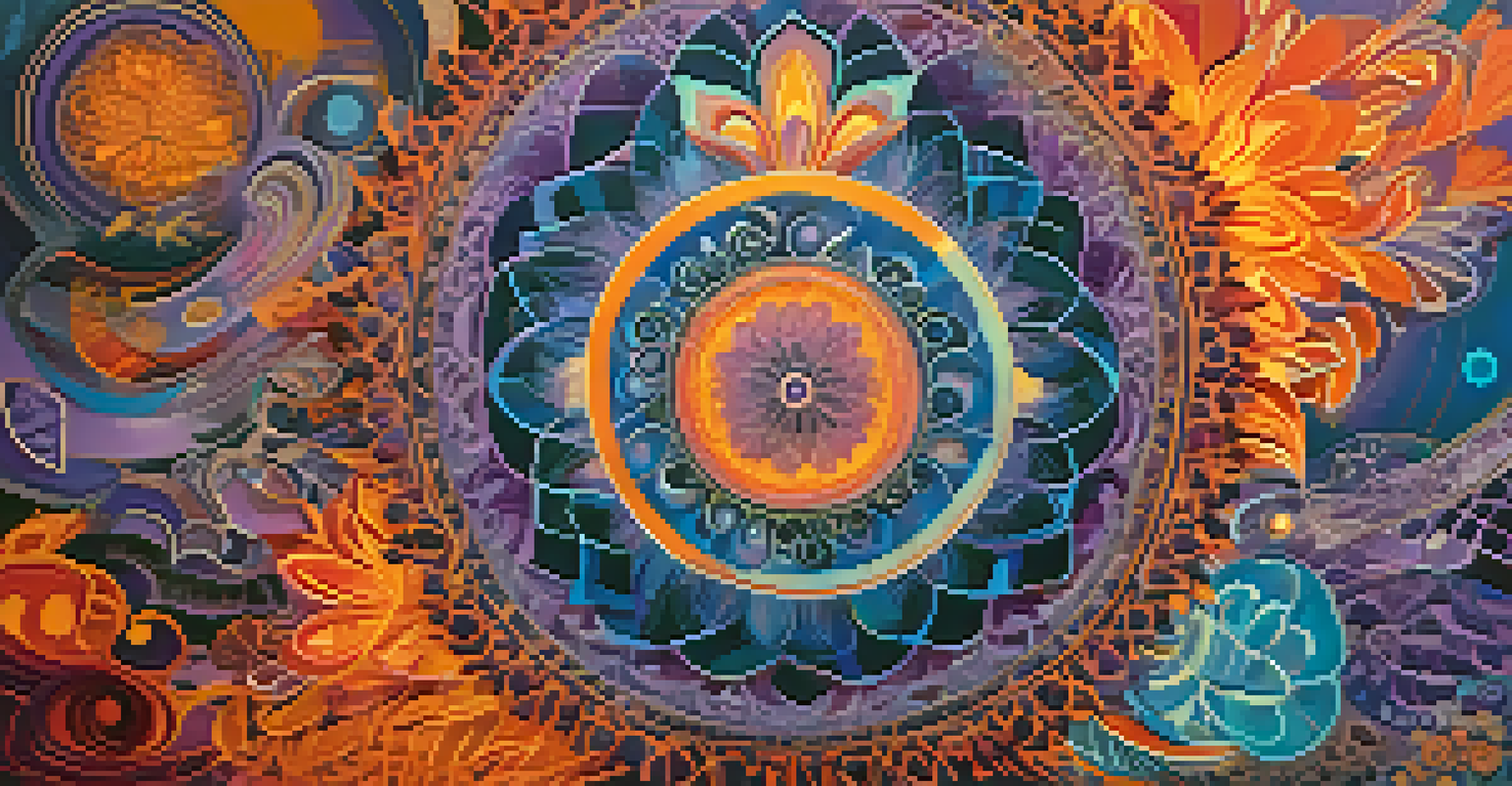Cultural Contexts of Psychedelics: A Global Perspective

Understanding Psychedelics: A Brief Introduction
Psychedelics are substances that alter perception, mood, and cognitive processes. Common examples include psilocybin mushrooms, LSD, and ayahuasca. These compounds have been utilized for centuries in various cultures, often for spiritual or therapeutic purposes.
Psychedelics can help us understand the mysteries of consciousness and provide a profound sense of connection to ourselves and the universe.
The fascinating aspect of psychedelics is their dual role; they can provide profound insights and healing experiences while also being associated with recreational use. This duality has led to a complex relationship with these substances across different societies.
In recent years, the resurgence of interest in psychedelics for mental health treatment has sparked discussions about their cultural significance. Understanding their historical contexts is crucial to appreciating their potential benefits in modern society.
Ancient Traditions: Indigenous Use of Psychedelics
Many indigenous cultures have long embraced psychedelics as sacred tools for spiritual connection. For instance, the use of peyote by Native American tribes is a profound ritual that facilitates communal bonding and personal insight.

Similarly, the Amazonian brew ayahuasca has been integral to the spiritual practices of various tribes, enabling participants to explore their consciousness and connect with nature. These practices highlight the deep-rooted cultural reverence for these substances.
Psychedelics' Cultural Significance
Psychedelics have deep historical roots in various cultures, serving as sacred tools for spiritual connection and healing.
This rich history showcases how indigenous communities view psychedelics not merely as drugs but as essential components of their spiritual and cultural identity. This perspective contrasts sharply with the often stigmatized view in Western societies.
Psychedelics in Eastern Philosophies and Practices
In Eastern cultures, psychedelics like psilocybin and cannabis have been used in spiritual practices for centuries. For example, in some Buddhist traditions, certain mushrooms are utilized to enhance meditative experiences.
The challenge is to find a way to integrate these ancient practices into a modern therapeutic context, respecting the cultural roots while addressing contemporary needs.
These practices illustrate a unique integration of psychedelics into philosophical systems, emphasizing mindfulness and awareness. They often aim to transcend ordinary consciousness and explore deeper existential questions.
The cultural acceptance of psychedelics in Eastern philosophies contrasts with the more transactional view often seen in the West, where the focus may be more on personal pleasure or escape rather than spiritual growth.
Psychedelics and Modern Western Culture
The modern Western perspective on psychedelics has evolved significantly over the past few decades. Initially, these substances were largely demonized, especially during the 'War on Drugs' era. However, recent studies highlighting their therapeutic potential have begun to shift this narrative.
Today, many researchers and mental health professionals advocate for the responsible use of psychedelics in treating conditions like PTSD, depression, and anxiety. This emerging acceptance is indicative of a broader cultural shift towards holistic and integrative approaches to mental health.
Evolving Western Perspectives
The modern Western view of psychedelics is shifting from stigma to acceptance, recognizing their potential therapeutic benefits.
As the stigma surrounding psychedelics lessens, there is a growing interest in understanding their historical contexts and cultural significance. This exploration is crucial for fostering a more nuanced dialogue about their role in society.
Psychedelics in Popular Culture: A New Narrative
Psychedelics have made significant inroads into popular culture, often symbolizing rebellion, creativity, and exploration of consciousness. Iconic figures in music and art, such as The Beatles and Salvador Dalí, have famously embraced these substances, shaping cultural perceptions.
Through literature, film, and music, psychedelics are frequently portrayed as catalysts for profound transformation. These narratives can inspire curiosity and open-mindedness, prompting individuals to explore their own consciousness.
However, it’s essential to approach these portrayals critically, recognizing that they can sometimes glamorize or oversimplify the complexities of psychedelic experiences. Understanding the cultural contexts behind these representations fosters a more balanced view.
The Role of Psychedelics in Contemporary Therapy
The therapeutic potential of psychedelics is generating exciting discussions among mental health professionals. Research has shown promising results, particularly for conditions like depression, anxiety, and addiction, leading to a burgeoning field of psychedelic-assisted therapy.
This approach often involves guided sessions where patients consume psychedelics in a controlled environment, supported by trained therapists. The goal is to facilitate deep introspection and emotional processing, resulting in transformative healing experiences.
Global Legal Status Variations
The legal status of psychedelics differs globally, reflecting diverse cultural attitudes and the importance of indigenous practices.
As more clinical trials emerge, it’s vital to understand the ethical implications and cultural contexts of these therapies. This awareness ensures that the benefits of psychedelics are harnessed respectfully and effectively.
Global Perspectives: Legal Status of Psychedelics
The legal status of psychedelics varies widely around the globe, reflecting differing cultural attitudes. In some countries, like Brazil and Peru, ayahuasca is legally recognized for religious and therapeutic use, while in others, psychedelics remain strictly prohibited.
This disparity highlights the cultural values and historical contexts influencing drug policy. Countries that embrace indigenous practices often have a more lenient approach to psychedelics, recognizing their spiritual and therapeutic importance.

Understanding these global perspectives is crucial for fostering international dialogue about drug policy reform and harm reduction strategies. A more informed approach can pave the way for responsible psychedelic use worldwide.
Looking Ahead: The Future of Psychedelics in Society
As interest in psychedelics continues to grow, so does the importance of integrating cultural contexts into the conversation. This integration can enhance our understanding of their potential benefits and risks, promoting responsible usage.
Future research and discussions should prioritize inclusivity, respecting the voices of indigenous communities and those historically marginalized in drug policy debates. This approach fosters a more comprehensive understanding of psychedelics within a global context.
Psychedelics: Cultural Perspectives
Psychedelics have deep-rooted cultural significance in various societies, often serving spiritual and therapeutic roles.
Ultimately, the future of psychedelics in society hinges on our ability to learn from diverse cultural narratives and practices. Embracing this global perspective can lead to a more informed and respectful relationship with these powerful substances.